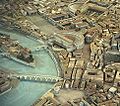Marcellus Theater
The Marcellus Theater was a theater in ancient Rome that still exists as a residential building today. Already Julius Caesar had the area to the north of the vegetable market (forum Holitorium) in the immediate vicinity of the magnificent temple of Apollo Sosianus acquired. There Augustus left the 13 BC He built a completed building dedicated to his nephew and designated successor Marcellus , who had died 10 years earlier . Two smaller temples had to be demolished for the construction, presumably dedicated to the Pietas and Diana . Unlike Greek theaters , the Marcellus Theater was not built on a mountain slope, but was a free-standing building. The approximately 33 meter high building made of Roman travertine from the quarries of Tivoli and opus caementicium provided the model for the construction of the Colosseum that was later built . It was the largest theater in the city of Rome in terms of seats and had an audience of around 10,000 to 15,000.
Decay began at the end of the 4th century AD. The theater was increasingly used as a quarry, like many public buildings in Roman antiquity. In the Middle Ages, the remaining parts were used as living space. Residential houses were built on the first two rows of arcades .
The Fabii (Faffi) family converted the theater into a fortress called monte Faffo in the 12th century , which fell to the Savelli family in 1386 . In the 16th century a renaissance- style palazzo was built on the foundations of the theater , which was taken over by the noble Roman Orsini family in 1712 . This condition is still preserved today and the theater is still inhabited today.
From 1926 to 1932 the numerous additions to the theater were removed and the facade was exposed again up to antique street level. The proscenium has not been exposed, but is documented by the Forma Urbis Romae .
Theater of Marcellus viewed from the Capitol
The Marcellus Theater in a model (to be visited in the Museo della Civiltà Romana )
literature
- Paolo Fidenzoni, Antonio Maria Colini : Il teatro di Marcello. Edizioni “Liber”, Rome [1969].
- Annarosa Cerrutti Fusco: Il Teatro di Marcello. Trasformazioni di forme e di significati. In: Quaderni dell'Istituto di Storia dell'Architettura. Volume 34/39, 1999/2002, pp. 83-94.
Web links
- Marcellus Theater in the Arachne archaeological database
- Theatrum.de - Website of the Regional Archeology Department Mainz: Rome, Theater des Marcellus
- Roma Antiqua - Rome on the Net: Theater of Marcellus
Coordinates: 41 ° 53 '30.9 " N , 12 ° 28' 46.1" E





